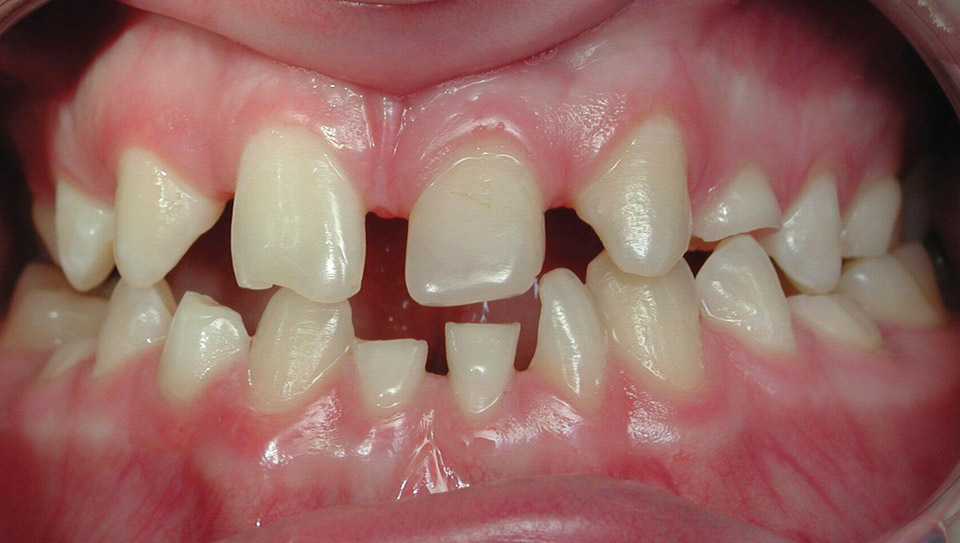
During these challenging economic times, learning to be flexible in developing treatment plans will help dentists sustain their production. Many patients may choose to forego a proposed treatment plan because of high costs. By understanding and adapting to the financial duress that can influence a patient’s motivation for treatment, dentists can strengthen the likelihood of a patient following through with a treatment plan.
One unusual case I had last year began in the spring—coincidentally at the time I attended one of Arrowhead Dental Lab’s continuing education courses. There, Dr. Dick Barnes addressed dentistry and the current financial circumstances of our country. I’m sure Dr. Barnes didn’t realize at the time how appropriate and timely his remarks would be in changing my approach to developing treatment plans for my patients. He suggested that dentists could provide quality treatment and financial leeway by looking for ways to lengthen a patient’s treatment time.
Radica temporaries
One method to lengthen treatment time is to incorporate Radica resin-designed temporaries into the treatment. Utilizing these temps would allow time to fix an urgent problem immediately through transitional[HC1] means while affording the patient more time to maneuver financially. This approach provides the desired aesthetics and durability until the patient is ready for the final treatment phase, whether it be implants, porcelain coverage, or another treatment modality.
Radica temps are a lab-processed provisional material that combines high flexural strength characteristics with great aesthetics. This temporary material is easy to work with and easy to reline and repair. It can be fabricated to make placement very intimate with the preparation of the teeth. Radica’s monomer-free formulation and extra-oral cure results in lower sensitivity, and its wear resistance and superior strength make single-tooth and full-mouth reconstruction very durable. Additionally, crack and break repair is easy. To repair, simply roughen the repair area with a bur or use air abrasion. Clean surface thoroughly, treat with a primer bonding adhesive and cure lightly. Place a flowable resin material to repair area and cure.
Case study
In my recent case, a 14-year-old male was congenitally missing 11 permanent teeth and had a minor open bite with slight cross-bite occlusion. Spacing was random throughout. I approached the case with thoughts of using transitional means, primarily because of the patient’s age, and I attempted to use all of his primary retained teeth, none of which were loose (figure 1).
I performed orthodontic movement, gingival recontouring, chairside composite design of certain teeth, and finalization using slight tooth preparation in which Radica temporary transitional coverage would be incorporated. The composite restorations existed primarily on lower primary and misshapen teeth.
For orthodontic movement, I bracketed the full upper to level and align the arch and to move the midline to the left, creating lateral space on the right side. I used the patient’s left cuspid for lateral design and opened distal space for cuspid formation using the primary retained cuspid as a bicuspid. Chairside composite build-ups on the lower arch enhanced the function and aesthetics of all the patient’s retained primary teeth.
I also performed a frenectomy using a CO2 Deka laser and did some minor gingival recontouring of 8 and 9. I let the tissue heal for two weeks before resuming any further treatment. Following the debracketing—similar to a veneer case—I broke the contacts and placed light preps, creating gingival and appropriate margins. Next, I took digital impressions using Itero technology for the upper Radica temp design. The patient wore an invisible retainer while the temporaries were made at Arrowhead Lab. The temporaries were designed in two segments, meeting between 8 and 9. I chose to secure the temps using a resin-bonding cement for longer endurance, and recommended the patient use a water pick and other hygiene aids.
Time and flexibility
The temporary stage of the treatment is complete, and it provides both aesthetics and function. Recall appointments initially will be held more frequently than six months, but the patient ultimately will have visits every six months.
Using Radica temps in this case has allowed more time for arch growth and development. Also, the extended treatment plan has given the patient more time to prepare financially and has allowed me more time to prepare the patient’s mouth for possible implant placement, aesthetic design, and the final use of porcelain.
This case will last longer than other similar cases I have started with this style of treatment. The patient may have Radica temps for seven years or longer, but the beauty of this approach is that I can remove segments of the temps in stages and replace missing or failed primary teeth as time proceeds. The use of Radica has been extremely beneficial for this young patient. In a matter of months, we gave him a great smile without breaking the bank.












